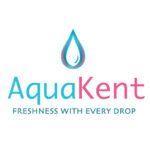Welcome to Aqua Kent, your water dispenser expert. If you’re here, chances are you’re curious about reverse osmosis water filters. As water dispenser experts, we’re here to break it down for you in simple terms. We’ll explore how they work, their benefits, their limitations, and practical tips to make the most of your RO system.
What is Reverse Osmosis?
Reverse osmosis is a water purification process that removes contaminants, impurities, and dissolved solids by forcing water through a semi-permeable membrane. Polluted water with the tiniest particles as small as 0.0001 micron can be separated away from clean water. This technology is widely used in homes, offices, and industries to ensure access to clean and safe drinking water.

Cross-section of Reverse Osmosis Membrane.
How Does a Reverse Osmosis Water Filter Work?
The process involves several stages:
- Pre-filtration: Removes larger particles like sediment and dirt.
- RO Membrane: Filters out dissolved salts, heavy metals, and other impurities.
- Post-filtration: Further improves taste and odour.
Imagine it like a sieve but way more advanced. The result? Crystal-clear, pure water.
Benefits of Reverse Osmosis Water
- Removes Harmful Contaminants: Eliminates up to 99% of impurities, including heavy metals, bacteria, and viruses.
- Improves Taste: Reduces odours and unpleasant tastes from chemicals like chlorine.
- Safe for Sensitive Health Conditions: Recommended for patients requiring mineral-free water.
Why Do Doctors Recommend Reverse Osmosis Water?
Doctors often advise patients with kidney issues, compromised immune systems, or certain chronic illnesses to drink RO water because it is free of harmful contaminants that could exacerbate their conditions.
What Type of Patients Benefit Most?
- Kidney Patients: RO water reduces the strain on kidneys by eliminating excess minerals.
- Cancer Patients: Safe, contaminant-free water minimizes the risk of infections.
- Immunocompromised Individuals: Ensures a germ-free and toxin-free hydration source.

Reuse RO Waste Water
Wastewater Management in Reverse Osmosis Systems
RO systems reject 3-4 times more water than they purify. This reject water, however, can be reused:
- Gardening: Suitable for watering plants, provided salt content is low.
- Cleaning: Ideal for mopping floors or washing vehicles.
- Recycling: Advanced setups can recycle reject water back into the system or direct it to non-potable water systems in homes or buildings.
How to Minimize Waste?
- Use high-efficiency RO membranes.
- Opt for systems with adjustable recovery rates.
- Regularly maintain the system to optimize performance.
Calculations for Reverse Osmosis Performance
Reverse Osmosis Performance Formulas
1. Salt Rejection Percentage
This formula calculates the efficiency of a reverse osmosis system in rejecting salts.
2. Salt Passage Percentage
Determines the percentage of salts that pass through the membrane.
3. Recovery Percentage
Percentage of feed water that is converted into permeate (clean water).
4. Concentration Factor
Indicates how concentrated the feed water becomes after the RO process.
5. Flux Rate
Measures the volume of water passing through the membrane per unit area.
6. Mass Balance
Verifies the accuracy of system performance data by ensuring input equals output in terms of flow and contaminants.
The Negative Effects of Drinking Reverse Osmosis Water
While RO water is highly purified, it lacks essential minerals like calcium and magnesium. This can lead to concerns about mineral deficiencies over prolonged use. However, adding a remineralization filter to your system can restore these nutrients and balance the water’s pH levels.
What is the disadvantage of a reverse osmosis filter?
The main disadvantages of RO filtration include:
- Mineral Loss: It removes both harmful contaminants and beneficial minerals, leaving water with minimal nutritional value,
- Water Wastage: RO systems can reject up to 3-4 litres of water for every litre purified. However, the reject water can be reused for non-drinking purposes such as cleaning or gardening.
- Energy Use: High-pressure pumps in RO systems consume more energy compared to basic filtration methods.
Commonly Asked Questions
Is it Healthy to Drink Reverse Osmosis Water?
es, reverse osmosis (RO) water is safe and healthy for consumption because it is highly purified and free from contaminants such as heavy metals, chemicals, and pathogens. In Singapore, desalinated water—processed using RO—contributes about 10% of the national water supply under PUB’s Four National Taps strategy. While RO removes beneficial minerals, Singapore’s strict water quality monitoring ensures potable water remains safe. According to PUB, the water supplied meets the World Health Organization (WHO) drinking water standards
Is Singapore tap water reverse osmosis?
Singapore’s tap water is not entirely processed through reverse osmosis. PUB employs a multi-stage water treatment process that includes coagulation, sedimentation, filtration, chlorination, ozonation, and UV treatment for water from reservoirs and imported sources. However, reverse osmosis is used for desalination and in producing NEWater, which contribute 10% and 30% of the nation’s water supply, respectively
Is Reverse Osmosis a Good way To Filter Water?
Yes, reverse osmosis is highly effective for filtering water and is the core technology behind Singapore’s desalination plants, which convert seawater into potable water. RO removes up to 99% of impurities, including dissolved solids, salts, and contaminants. Additionally, PUB uses RO in the production of NEWater, which meets industrial and potable water needs, showcasing the reliability of RO for sustainable water management
Is RO water good for the kidneys?
Yes, RO water is often recommended for individuals with kidney conditions. The filtration process removes harmful substances like sodium, heavy metals, and other impurities, which are particularly important for patients with compromised kidney function. Research indicates that reduced sodium levels in RO water are beneficial for managing blood pressure and kidney health.
Final Thoughts
Reverse osmosis systems are a fantastic solution for clean and safe drinking water. With proper maintenance, waste management, and remineralization, you can enjoy the benefits of RO water while minimizing its drawbacks. For more expert advice and solutions, visit Aqua Kent at aquakentro.com.sg.








